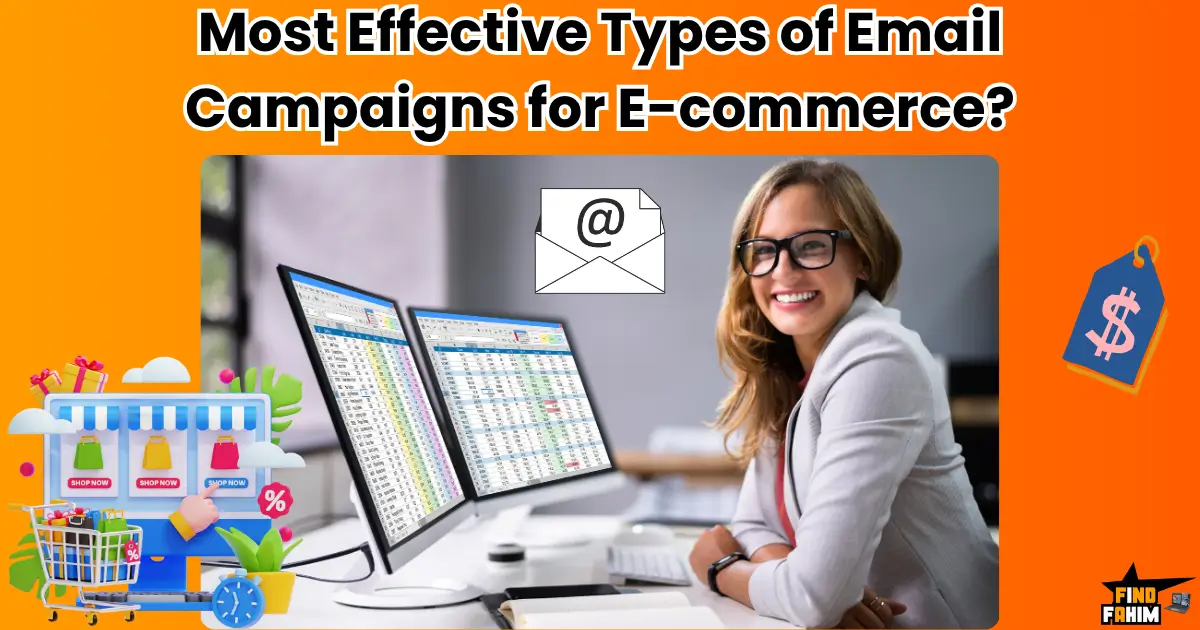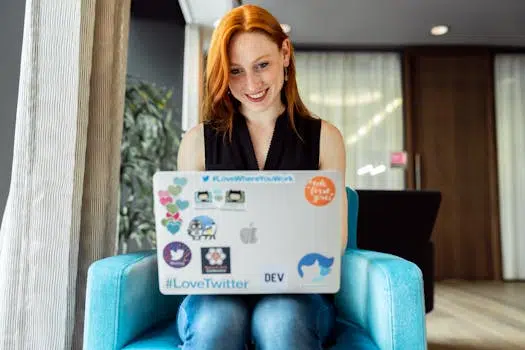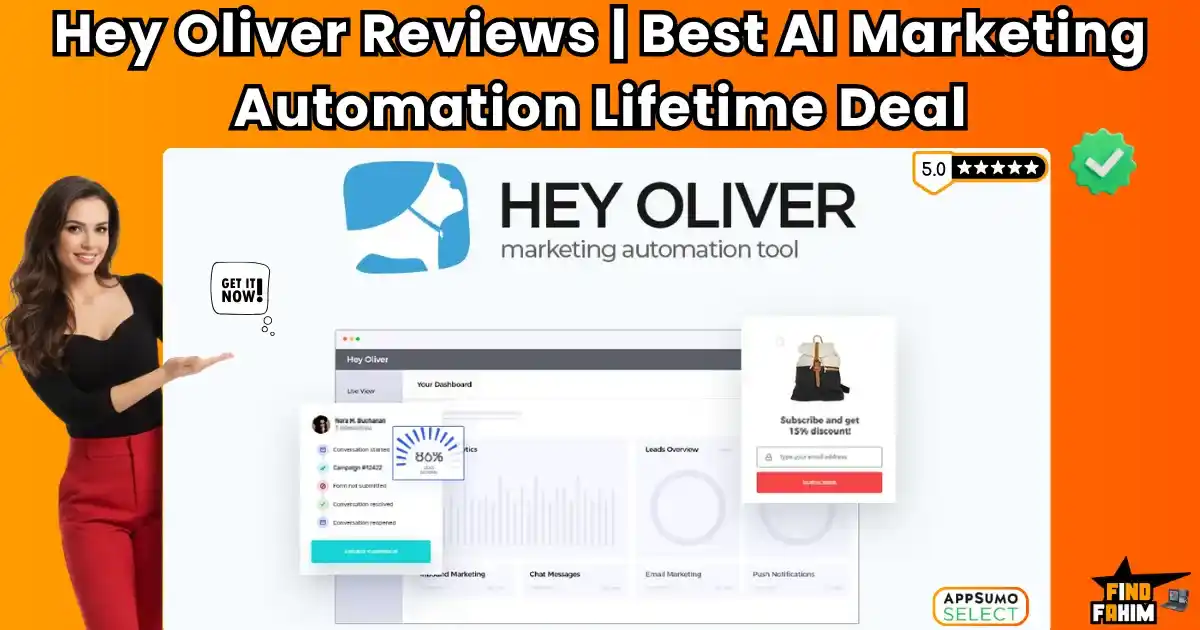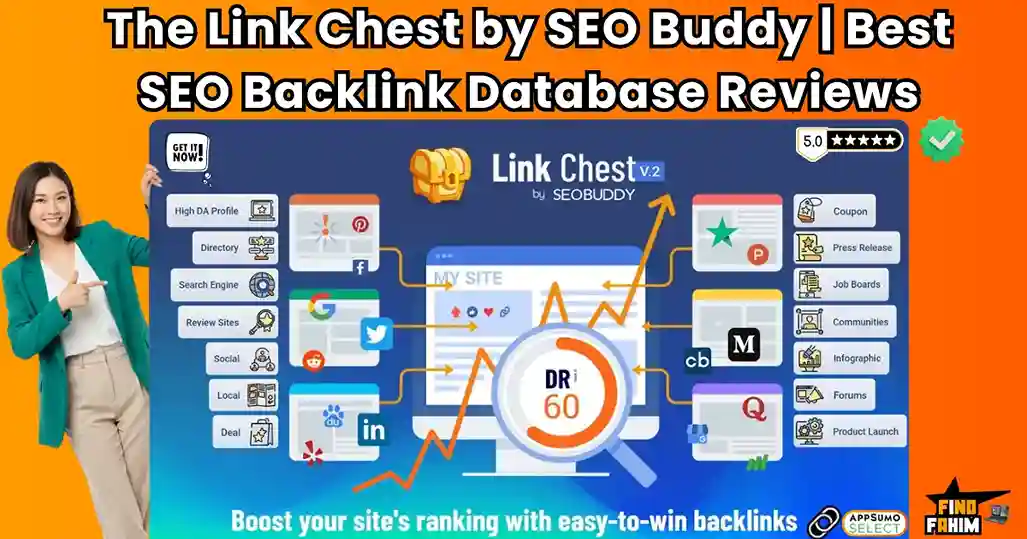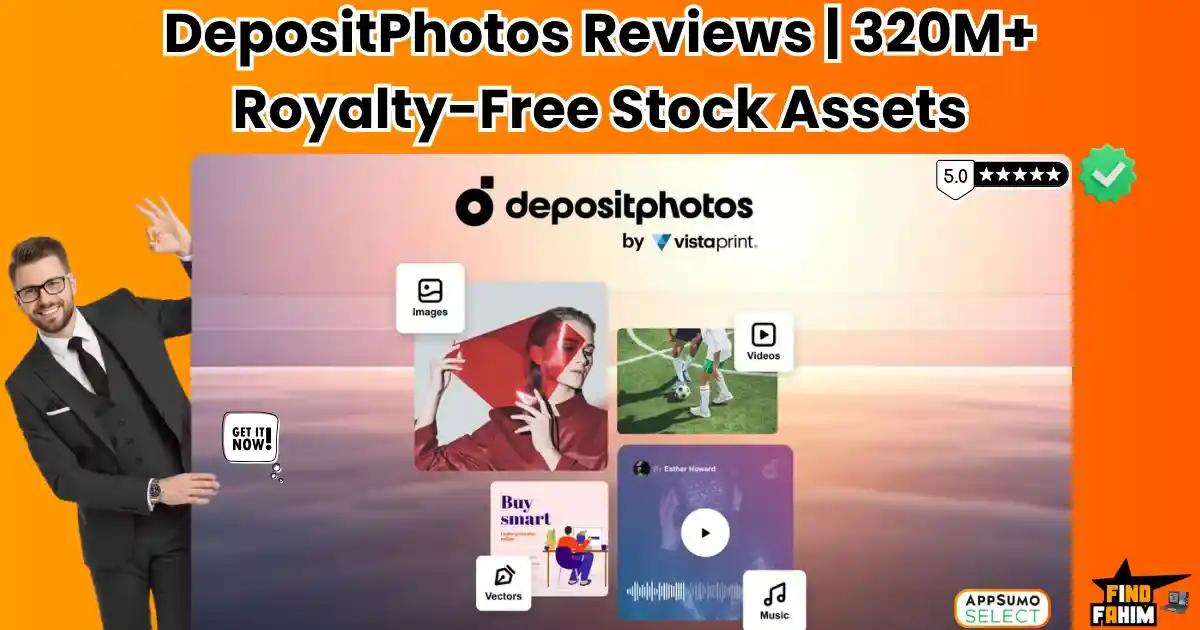If you run an online store, you probably spend a lot of time thinking about traffic. How do I get more people to my site? How do I get my products seen on social media? I get it, I’ve been there. But what if I told you that one of the most powerful tools for growing your business is something you already have? It’s your email list.
Table of Contents
ToggleWhat Are the Most Effective Types of Email Campaigns for E-commerce?
I’ve learned over the years that just sending random newsletters or sales blasts doesn’t cut it. The real magic happens when you start using specific types of email campaigns that are designed to talk to your customers at the perfect moment. We’re talking about emails that feel personal, helpful, and incredibly effective.
How effective? Well, I did my research, and the latest statistics show that for every $1 you spend on email marketing, you can expect an average return of around $42. That’s just unbelievable!
In this guide, I’m going to walk you through the most powerful email campaigns that every e-commerce store—whether you’re on Shopify, WooCommerce, or another platform—should be using. I’ll share what they are, why they work, and how you can get started. I think you’re going to love what these can do for your business.
Before we jump into the different types of campaigns, I want to take a quick second to talk about why email is still the king of e-commerce marketing. I know there are a lot of flashy new things to chase, but I’ve learned from my own experience and from helping my clients that a strong email strategy is the foundation of a healthy, growing online store.
Why Email Marketing Remains the #1 Growth Channel for E-commerce
It’s easy to get caught up in trying to get more followers on Instagram or running the perfect Facebook ad. And those things are important! But email marketing is different. It’s your secret weapon for a few really big reasons.
First, the numbers don’t lie. When it comes to actually making a sale, email blows other channels out of the water. Its conversion rates are consistently higher than those from social media or even paid ads. People on your email list have chosen to hear from you, so they’re already warmed up and interested.
Second, email allows you to talk to your customers throughout their entire journey with your brand. From the moment they first discover you, to their first purchase, and long after, you can send messages that are perfectly timed and relevant. This is what we call lifecycle marketing, and it’s how you turn a one-time buyer into a lifelong fan.
And maybe the most important reason of all: you own your email list. Your social media followers? You’re just renting them from another company. If that platform’s algorithm changes tomorrow, your reach could disappear overnight. But your email list is your private channel. No one can take that away from you. It’s a real asset for your business that helps you build trust, automate your revenue, and increase the lifetime value (LTV) of your customers.
Okay, let’s start with the very first email your new subscribers should get. This isn’t just a simple “hello”; it’s your first real chance to make a great impression and start building a relationship. If you get this one right, you set yourself up for so much success down the road. I’ve seen this work wonders for my clients.
Welcome Email Campaigns: Set the First Impression Right
Your welcome email (or even better, a welcome series of 2-3 emails) is probably the most important email you will ever send. Why? Because people are expecting it, and they’re excited to get it!
I was blown away when I first saw the stats on this. Welcome emails have an average open rate of over 50%! That’s way higher than most other types of emails. People are at their most engaged right after they sign up, so you have to make this moment count.
So, what should you put in your welcome email?
- A Warm, Personal Greeting: Say thank you for subscribing and introduce your brand’s personality.
- A First-Time Buyer Incentive: This is huge! Offering a small discount, like 10% or 15% off their first order, is a powerful way to turn that new subscriber into a customer right away.
- Showcase Your Best Stuff: Don’t make them hunt around your site. Show them what people love! Include links to your best-selling products, your new arrivals, or your most popular collections.
Here’s a simple automation tip: You can set this up in almost any email tool. Just create a rule that says, “When someone new subscribes to my list, automatically send them this welcome email.” It’s a set-it-and-forget-it way to make a perfect first impression every single time.
Okay, this next one is a huge money-maker. I mean, if you set up only one automated email campaign after your welcome series, it should be this one. I’m talking about cart abandonment emails. It still shocks me how many online stores don’t use these, because they are leaving so much money on the table!
Cart Abandonment Emails: Recover Lost Revenue on Autopilot
Let’s look at the facts. I researched this, and studies show that around 70% of all online shopping carts are abandoned. That’s a massive number! People get distracted, they have second thoughts about the price, or their cat walks across the keyboard. It happens.
But here’s the unbelievable part: you can win back 10-15% of those seemingly lost sales just by sending a few automated emails. That’s like free money for your business!
The best practice I’ve seen work is a simple 3-email sequence:
- Email 1 (after ~1 hour): This is a gentle, helpful reminder. “Hey, did you forget something?” Show a picture of the item(s) they left in their cart. Sometimes, a simple reminder is all it takes.
- Email 2 (after ~24 hours): This one can add a little social proof or urgency. “Your items are selling fast!” or “See what other customers are saying about this product.”
- Email 3 (after ~48-72 hours): This is where you can bring out the big guns if you want to. Offer a small discount, like free shipping or 10% off, to give them that final nudge to complete their purchase.
I highly recommend using images of the actual items they abandoned. Seeing that beautiful product again can be a powerful emotional trigger. This one automated campaign can become one of your biggest and most reliable sources of revenue. You’ll love seeing those sales come in while you sleep!
So, someone just made a purchase. Hooray! Your job is done, right? Not even close! The time right after a customer buys from you is a golden opportunity. They are feeling excited and happy with their decision. This is your chance to make them feel amazing about their purchase and turn them into a repeat customer for life.
Post-Purchase Campaigns: Build Loyalty After the Sale
A good post-purchase email sequence does more than just say “thanks for your order.” It guides your customer through the entire experience and makes them feel cared for. This is how you build real brand loyalty.
Here’s what a great post-purchase flow looks like:
- The Order Confirmation: Send this immediately. It should clearly show what they bought, how much they paid, and where it’s being shipped. This gives them peace of mind.
- The Shipping Confirmation: Send this as soon as the order ships. Include the tracking number so they can get excited watching their package come to them.
- The “Thank You” & How-To: A few days after they receive their order, send a thank you email. You could include tips on how to use their new product or how to care for it. This shows you care about their experience.
- The Review Request: A week or two later, ask for a review! This is so important for social proof.
I’ve seen this work so well for my clients. A good post-purchase series helps reduce buyer’s remorse, and it’s the perfect time to gently upsell or cross-sell. For example, in the “thank you” email, you could say, “People who bought [the product they bought] also loved [a related product].” It feels helpful, not pushy. You can also use these emails to encourage them to share photos of their purchase on social media (we call this user-generated content, or UGC) or to refer a friend.
One of the best things about having an online store is that you can see what your customers are interested in. You can use that data to send them super-personal and helpful emails that feel like they were written just for them. That’s where product recommendation emails come in, and they work like a charm.
Product Recommendation Emails: Personalized Upsells that Convert
Have you ever been on a site like Amazon, and it shows you a list of products and says, “You might also like…”? That’s exactly what this type of email campaign does, and it’s incredibly powerful.
You can send these personalized recommendations based on a few different things:
- Past Purchases: If a customer bought a coffee machine from you, you could send them an email a few weeks later recommending your best-selling coffee beans.
- Browse Behavior: If you see a customer has been looking at a certain category on your site, like “summer dresses,” you can send them an email showcasing your newest dress arrivals.
- General Best-Sellers: You can send emails to your whole list with subject lines like “Picked Just for You” or “Our Top-Rated Products This Week.”
This strategy works so well with modern email marketing tools like Klaviyo or Omnisend. These tools have AI features that can automatically create and send personalized recommendation emails for you.
Here’s a tip I’ve seen work well: create a customer segment of everyone who has bought something from a specific category, like “skincare.” Then, when you launch a new skincare product, you can send a special announcement email just to that super-interested group. The conversion rates on emails like that can be unbelievable!
Over time, it’s normal for some people on your email list to stop opening your emails. They might have changed their interests, or maybe they just forgot how awesome your brand is! But you don’t have to let them go without a fight. A “win-back” campaign is your chance to reignite that spark and bring them back.
Win-Back Campaigns: Reignite Cold Leads and Inactive Shoppers
A win-back campaign is an automated email or series of emails that gets sent to subscribers who haven’t opened, clicked, or bought anything from you in a while. I usually recommend setting this up to trigger after about 60 or 90 days of inactivity.
The goal here is to get their attention and remind them why they liked you in the first place. You can try a few different approaches:
- The “We Miss You” Discount: This is a classic for a reason! A subject line like “We Miss You! Here’s 20% Off to Come Back” can be very effective.
- Showcase What’s New: Maybe they just haven’t seen your latest products. Send an email highlighting your newest arrivals or best-sellers.
- The Simple Question: You can send a really simple, personal-feeling email that asks, “Are you still interested in hearing from us?” This can be a great way to clean your list, as it prompts people who are no longer interested to unsubscribe.
Here’s a best practice to keep in mind: you don’t want to bombard your inactive subscribers with too many emails, as this can hurt your sender reputation and make you look like spam. A short, thoughtful sequence of 2-3 emails is usually best. A good win-back campaign can bring a surprising number of old customers back into the fold and make them feel valued again.
You know who the most important people are for your e-commerce business? Your repeat customers! These are your loyal fans, your biggest supporters. And you should treat them like the VIPs they are. A loyalty and rewards program, promoted through email, is the perfect way to make your best buyers feel extra special.
Loyalty and Rewards Program Emails: Make Repeat Buyers Feel Special
If you have a loyalty program where customers can earn points for their purchases, email is the perfect channel to keep them engaged with it. You can set up automated emails that get sent when they hit important milestones.
Imagine how excited your customer would be to get an email that says:
- “Wow! You just reached VIP status! Here’s your exclusive perk…”
- “You have enough points for a gift! Come and claim it.”
- “You get early access! Shop our new collection 24 hours before anyone else.”
These kinds of emails make your customers feel seen and appreciated. I’ve seen this work incredibly well for beauty and fashion brands. They create exclusive “VIP tiers,” and once a customer spends a certain amount, they get an email welcoming them to the club with special benefits.
You can also use these emails to offer exclusive discounts just for your top buyers or to encourage them to refer their friends in exchange for bonus loyalty points. It’s a powerful way to build a community around your brand and dramatically increase the lifetime value of your customers.
Okay, let’s talk about the campaigns that everyone thinks of when they think about e-commerce emails: the big sales and promotions! These are your chances to create a lot of excitement and drive a big spike in revenue. But just sending an email that says “50% Off!” isn’t enough. You need a strategy to make it pop.
Promotional Campaigns: Sales, Seasonal, and Flash Offers
Promotional campaigns are all about creating excitement and urgency. These are often tied to big shopping holidays or special events. Think about:
- Big Seasonal Sales: Black Friday, Cyber Monday, Christmas, Eid, Diwali, New Year’s – these are huge opportunities.
- Last-Minute Flash Deals: A surprise 24-hour sale can create a huge rush of buying activity.
- Bundle Offers: “Buy this, get that free!” or “Get our 3 best-sellers for one low price!”
To make these campaigns work, you need to use some smart tactics. Urgency and scarcity are your best friends here. Use words like “Limited Time,” “While Supplies Last,” or “Sale Ends Tonight!” I also love using countdown timers right inside the email. Seeing that clock ticking down can be a powerful motivator!
For the email itself, make your layout super simple and clear. Use a big, bold headline with the offer, a beautiful image of the product, and a bright, unmissable Call to Action (CTA) button that says something like “Shop the Sale Now” or “Claim My Discount.” A well-run promotional campaign can be one of your biggest sales days of the year!
Launching a new product is such an exciting time! You’ve put so much work into it, and you can’t wait for the world to see it. Email marketing is your single best tool for making sure your launch is a huge success. You can use it to build up excitement and anticipation so that when you finally launch, you have a crowd of eager customers ready to buy.
Product Launch Emails: Create Buzz Around New Arrivals
Instead of just sending one email on launch day, the best strategy is to create a teaser series. This is a sequence of emails you send out in the days or weeks leading up to the launch. It builds hype and makes your subscribers feel like they are part of an exclusive event.
Here’s what a great product launch series might look like:
- The “Coming Soon” Teaser (1-2 weeks before launch): Announce that something new and exciting is on its way. Don’t reveal everything! Just give them a little hint to get them curious.
- The “Sneak Peek” Preview (a few days before launch): Show them a little more. Maybe a cool photo of the new product, a list of its amazing benefits, or even some quotes from influencers or beta testers who have already tried it. Including a short video or GIF of the product in action works amazingly well here!
- The “Launch Day” Announcement (on launch day!): This is the big one! Announce that the product is officially available. Make the CTA button big and clear: “Shop Now!”
To make your launch feel even more special, you can offer early bird discounts or beta access just for your email subscribers. This makes them feel like insiders and rewards them for being on your list.
Have you ever spent time on a website, clicking around and looking at a few different products, but then you get distracted and leave without buying anything or even adding an item to your cart? We all do it! We’re all “window shoppers” sometimes. A browse abandonment email is a super smart way to re-engage those people.
Browse Abandonment Emails: Capture Window Shoppers
This is a bit more advanced than a cart abandonment email, but it’s incredibly effective. A browse abandonment email is automatically triggered when a known subscriber on your list visits your site, looks at specific products, but then leaves without taking any action.
The email can say something like, “Hey, we saw you were looking…” and then, here’s the magic part: it can show them pictures of the exact products they were just looking at! How cool is that? It’s super personal and super relevant.
This type of email works well when you combine it with some friendly, low-pressure scarcity copy, like “These popular items are selling fast!” You can even choose to offer a small discount to entice them to come back and take a second look.
You can also get smart with this by segmenting your audience. If someone were looking at products in your “Running Shoes” category, you can be sure they are interested in running. You can then add them to a segment to receive future emails about your running gear. It’s a powerful way to capture interested shoppers before they get away.
The people who have already bought from you are a goldmine of potential for your business. Not only are they the most likely people to buy from you again, but they can also become your best salespeople! All you have to do is ask them for their opinion. A customer review and feedback campaign is key to this.
Customer Review & Feedback Emails: Turn Buyers into Advocates
Social proof is one of the most powerful forces in e-commerce. People trust other people. When a potential new customer sees that your product has lots of great reviews, they feel much more confident about buying it.
So, how do you get those reviews? You ask for them with a simple, automated email! A week or two after a customer has received their product, send them a friendly email asking them to leave a rating or a review.
To make it even more likely they’ll do it, you can offer a little incentive. Something like:
- “Leave a review and get 100 bonus loyalty points!”
- “Share your thoughts and get 15% off your next purchase.”
You can also use this opportunity to ask for User-Generated Content (UGC). Encourage them to share a photo of themselves using your product on social media and to tag your brand.
Then, you can use all of these amazing reviews and customer photos in your other marketing emails! Highlighting great reviews in your welcome series or on your product pages can dramatically increase your conversion rates. It’s a beautiful cycle: you get feedback, you get social proof, and that social proof helps you get new customers.
This next one is a special bonus campaign type that is an absolute goldmine if you sell certain kinds of products. If you sell anything that people use up and need to buy again, like skincare, coffee, vitamins, or pet food, then you have to be using replenishment and subscription emails. They are amazing for boosting your revenue.
Bonus: Replenishment & Subscription Emails for Consumables
A replenishment campaign is a simple, automated email that reminds customers to re-order a product they’ve bought from you in the past, right around the time they are probably running low.
Imagine you sell a 30-day supply of skincare cream. You can set up an email to automatically go out to a customer 25 days after they bought it with a subject line like:
- “Looks like you’re running low!”
- “It’s time to restock your favorite cream!”
Make it super easy for them to re-order with a big “Buy Now” button that takes them right to the product page.
And here’s how you take it to the next level: in that email, you can also offer them an easy way to upgrade to a subscription. You could say something like, “Never run out again! Subscribe today and save 15% on every order.”
This type of campaign is proven to skyrocket your customer lifetime value (LTV) because it turns one-time buyers into loyal, recurring customers. It’s a win for them (they never run out of what they love) and a huge win for your business (predictable, recurring revenue!).
Wow, that’s a lot of different campaign types, right? Looking at this list, you might feel a little overwhelmed and think, “Do I need to set all of these up right now?” I get it! The good news is, you don’t have to do everything at once. The smart way to do this is to start with the most important ones and build from there.
Choosing the Right Email Campaign for Your E-commerce Strategy
So, where should you start? My advice is to always start simple. Don’t try to build a super complex email marketing machine on day one.
For almost every single e-commerce store, I recommend starting with what I call the “Big Three”:
- The Welcome Series: To make a great first impression and convert new subscribers.
- The Cart Abandonment Series: To automatically recover lost sales.
- The Post-Purchase Series: To build loyalty and get reviews.
These three campaigns alone can have a massive impact on your business and will run on autopilot, making you money while you focus on other things.
Once you have those three set up and running well, you can start adding more based on your store’s specific goals. If you want to increase the average order value, maybe you could add Product Recommendation emails next. If you have a lot of one-time buyers, you could focus on a Win-Back Campaign.
The key is to match your email campaigns to your customers’ lifecycle and your business goals. And don’t forget, you can make your emails even more powerful by tying them in with other marketing channels, like SMS or push notifications, for a truly seamless customer experience.
As you start building out these amazing email campaigns, I want to give you a quick heads-up about some common mistakes I see a lot of e-commerce store owners make. Knowing what to avoid is just as important as knowing what to do! I’ve learned from some of these myself, so hopefully, I can help you skip the frustration.
Common Mistakes to Avoid in E-commerce Email Marketing
Even with the best intentions, it’s easy to make a few slip-ups. Here are some of the most common mistakes to watch out for:
- Over-sending or Under-sending: Sending too many emails can annoy your subscribers and lead to them unsubscribing. But sending too few can make them forget who you are! Finding that sweet spot (for many stores, that’s 2-4 times a month for newsletters, plus your automated campaigns) is key.
- Not Segmenting Your List: Sending the same email to every single person on your list is a huge missed opportunity. As we talked about, segmenting your list allows you to send much more personal and relevant messages, which leads to way better results.
- Poor Mobile Design: So many people read their emails on their phones! If your email looks messy or is hard to read on a small screen, people will just delete it. Always make sure your emails look great on mobile.
- Weak Subject Lines or CTAs: Your subject line is what gets your email opened. Your Call to Action (CTA) is what gets people to click. Spend a little extra time making both of them clear, exciting, and compelling.
- Not Testing Your Campaigns! This is a big one! You should always be testing different things to see what works best for your audience. This is called A/B testing. You can test different subject lines, different offers, or different images to see which one gets a better response. The results can sometimes surprise you!
Avoiding these common mistakes will put you way ahead in the game and help make sure your email marketing efforts are as successful as possible.
Okay, so you’re excited to get started, but you’re wondering what tool you should use to do all of this cool stuff? That’s a great question, because choosing the right email marketing platform is important. The good news is, there are some amazing tools out there made specifically for e-commerce, and many of them even have free plans to get you started!
Best Tools for E-commerce Email Campaigns (With Free Plans)
I’ve worked with a lot of different email tools, and here are a few that I highly recommend for e-commerce businesses. I’ll break down who each one is best for.
Klaviyo (Recommended)
Who it’s for: This is a powerhouse tool, especially for growing or established Shopify stores.
Why I like it: It has incredibly powerful segmentation and automation features. It’s built from the ground up for e-commerce, so it understands things like customer lifetime value and can create really advanced personalized campaigns. Its integration with Shopify is seamless.
Free Plan: They usually offer a free plan for up to a certain number of contacts and email sends.
Omnisend:
Who it’s for: Great for beginner to growing e-commerce stores that want an all-in-one solution.
Why I like it: Omnisend is super user-friendly and combines email marketing with SMS (text message) marketing and web push notifications all in one place. Their templates are beautiful, and their automation workflows are easy to set up.
Free Plan: They have a great free plan that includes most of their core features, which is amazing for getting started.
Mailchimp:
Who it’s for: Good for beginners or businesses that are just starting to build their email list.
Why I like it: Mailchimp is famous for its easy-to-use interface. It’s very intuitive. It has good e-commerce features, especially if you’re just starting with the basics.
Free Plan: They have a free plan, but it has become a bit more limited in recent years, so be sure to check the current contact and sending limits.
Brevo (formerly Sendinblue):
Who it’s for: Businesses on a budget that need an all-in-one marketing platform.
Why I like it: Brevo offers a lot of features for a very competitive price. Besides email, it includes things like a CRM, chat, and landing pages. Their free plan is quite generous with the number of contacts you can have.
Free Plan: Yes, they have a solid free plan that is a great starting point.
My advice? If you’re serious about e-commerce, starting with a platform like Klaviyo or Omnisend is a really smart move because they are built specifically for online stores. But any of these tools can help you get started on the right foot!
We’ve covered so much ground together! From that first welcome email to winning back old customers, you now have a full playbook of the most effective email campaigns to grow your online store. I want to leave you with a few final thoughts to help you bring it all together and really start seeing results.
Final Thoughts: Mastering Email Campaigns to Scale Your Store
I hope you can see now that email marketing is so much more than just sending out a monthly newsletter. It’s the backbone of a scalable, profitable e-commerce business. Each of the campaign types we discussed is like a specialized tool in your toolbox—designed to help you connect with your audience and grow your revenue consistently.
The most important thing to remember is this: you don’t have to do everything at once. Email marketing mastery is a journey, not a race. Start small. Test what works. Segment your list. Iterate and improve. Begin with one campaign, analyze how it performs, learn from the data, and then gradually layer on the rest.
Email is your most valuable direct channel—a space you control, where you can truly build a loyal community around your brand. When you commit to sending the right message to the right person at the right time, the results will speak for themselves.
So here’s my challenge to you: Start with just one of these campaigns this week. Whether it’s setting up your welcome email or finally launching that cart abandonment flow—just take action. Your future self will thank you.
👉 View All the Latest Email Marketing Tools (Lifetime Deals) on AppSumo →
Discover powerful tools at low prices with exclusive offers.
FAQs (Your Questions Answered!)
What is the most profitable type of e-commerce email?
While it can vary, cart abandonment emails often have the highest direct ROI because they target customers who were just one click away from buying. Welcome emails are also incredibly profitable for converting new subscribers.
How often should I email my e-commerce customers?
Besides your automated campaigns (like welcome or cart abandonment emails), a good starting point for promotional emails or newsletters is 1-4 times per month. The key is to be consistent and always provide value so your audience looks forward to hearing from you.
Should I automate all my e-commerce emails?
You should automate as many as make sense! Campaigns like the welcome series, cart abandonment, post-purchase follow-ups, and win-back series are perfect for automation. This saves you a ton of time and ensures timely communication.
What email marketing tools work best for Shopify?
Tools like Klaviyo and Omnisend are famous for their deep, seamless integrations with Shopify. They can pull in all your customer and product data, which allows for incredibly powerful personalization and segmentation.
Can I do email marketing without always offering discounts?
Yes! While discounts are effective, your emails can provide many other types of value. You can share helpful content, announce new products, showcase customer stories, give early access, and build a community. It shouldn't always be about sales.
Hi, I’m Fahim — a SaaS tools reviewer and digital marketing expert with hands-on experience helping businesses grow using the right software. I research, test, and personally use a wide range of AI, business, productivity, marketing, and email tools for my agency, clients, and projects. I create honest, in-depth reviews and guides to help entrepreneurs, freelancers, startups, and digital agencies choose the best tools to save time, boost results, and scale smarter. If I recommend it, I’ve used it — and I only share what truly works.

